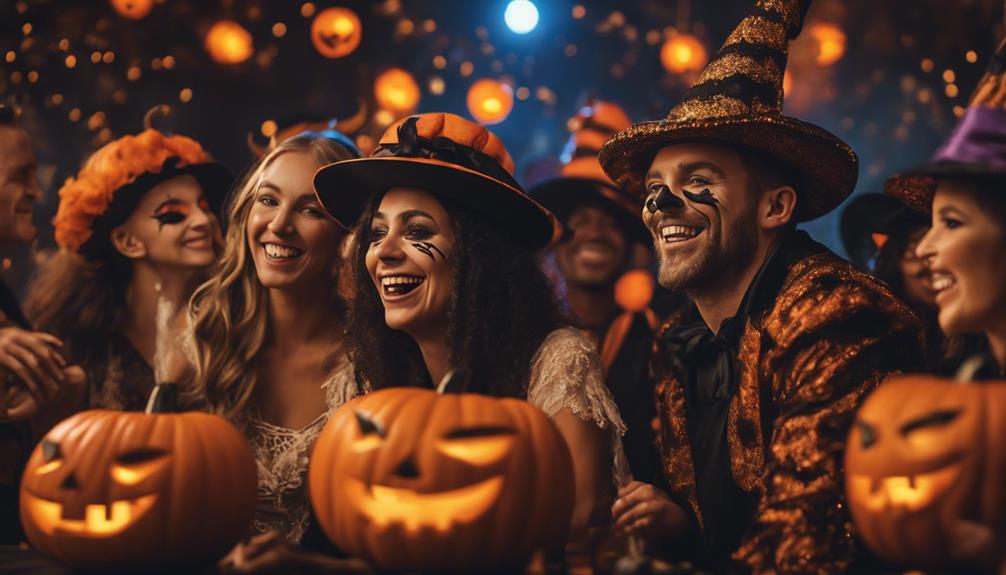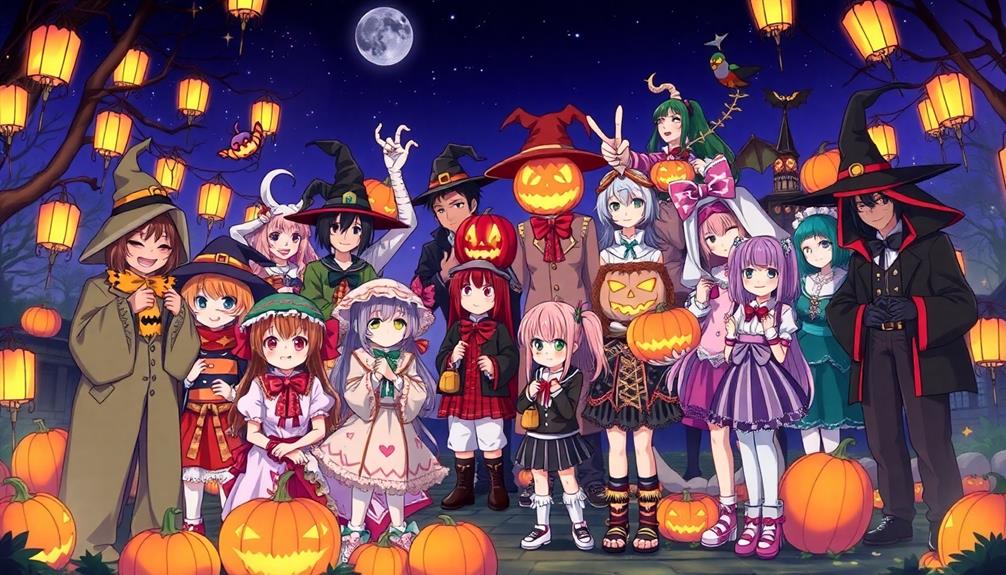When choosing a Halloween costume, it is crucial to respect cultural significance to avoid harmful stereotypes. Cultural appropriation occurs when elements from a marginalized culture are used without understanding, which can perpetuate negative narratives. Instead, aim for cultural appreciation by engaging with and honoring the culture's history. Avoid costumes that trivialize or mock, especially those featuring sacred items or stereotypes. Seek guidance from cultural representatives and educate yourself on the meanings behind your choices. This mindful approach not only enriches your experience but also fosters respect. You'll discover valuable insights on how to celebrate without causing offense.
Key Takeaways
- Cultural appropriation involves adopting elements from another culture without permission, often reinforcing stereotypes and trivializing their significance.
- Respectful cultural appreciation requires understanding and acknowledging the importance of cultural elements, fostering genuine engagement without exploitation.
- Avoid costumes that perpetuate harmful stereotypes, such as Native American attire or blackface, as they contribute to systemic inequalities.
- Engaging with cultures authentically includes participating in cultural events and supporting local artisans, which fosters appreciation and understanding.
- Consulting cultural representatives and researching historical significance helps ensure respectful costume choices that honor cultural identities.
Understanding Cultural Appropriation

Cultural appropriation happens when elements of one culture are adopted by a dominant culture without permission, often ignoring the original significance and context. This power imbalance can reinforce harmful stereotypes and lead to the economic exploitation of marginalized cultures.
When you wear traditional attire as a costume without understanding its cultural significance, you might trivialize and disrespect the origins of that attire.
It's essential to recognize that intent doesn't negate the impact of appropriation. Even if you believe your actions are harmless, overlooking the cultural significance of what you're adopting can still cause harm.
Understanding cultural appropriation requires you to distinguish between respectful cultural exchange and appropriation itself.
Respectful cultural exchange involves learning about and honoring the culture from which elements are drawn, while appropriation often results in commodification and misrepresentation.
By being mindful of this difference, you can guarantee that your choices—especially during occasions like Halloween—respect the rich traditions and meanings behind cultural elements.
Engaging with cultures in a thoughtful way helps you avoid appropriation and promotes a deeper appreciation for their significance.
The Importance of Cultural Appreciation

Understanding the importance of cultural appreciation is vital in today's diverse society. Unlike cultural appropriation, which often lacks context and respect, cultural appreciation involves engaging with another culture through understanding and acknowledgment of its significance. By participating in cultural events and supporting local artisans, you foster genuine appreciation and honor the culture without exploiting it.
Here's a simple table that illustrates the contrasts between cultural appreciation and cultural appropriation:
| Cultural Appreciation | Cultural Appropriation |
|---|---|
| Engages with respect and understanding | Often lacks context and meaning |
| Honors cultural significance | Exploits elements for personal gain |
| Encourages dialogue and sharing | Silences voices of marginalized communities |
Educating yourself about a culture's history and traditions before engaging with its elements promotes respectful interactions. Seeking permission and guidance guarantees your actions are respectful and acknowledge the perspectives of those represented. By recognizing the impact of cultural appropriation, you can advocate for the rights and narratives of marginalized communities, promoting social equity and deepening your cultural appreciation.
Examples of Costumes to Avoid

When choosing a Halloween costume, it's essential to steer clear of options that reinforce harmful stereotypes or misrepresent sacred cultural symbols.
Costumes like Native American headdresses or blackface not only disrespect the cultures they mimic but also perpetuate damaging narratives.
Costumes Reinforcing Stereotypes
Stereotypes can be damaging, especially when they're perpetuated through costumes that mock or trivialize cultural identities. When you choose a costume that reinforces harmful stereotypes, you're engaging in costume cultural appropriation and contributing to a cycle of misunderstanding and disrespect towards minority cultures. Here are some examples of costumes to avoid:
| Costume Type | Why to Avoid | Alternative Idea |
|---|---|---|
| Native American attire | Perpetuates harmful narratives and stereotypes. | Celebrate Native American history with a respectful educational theme. |
| "Sexy" versions of traditional clothing | Trivializes cultural significance and dignity. | Choose a costume that honors the culture without sexualizing it. |
| Blackface or caricatured portrayals | Reinforces systemic inequalities and offensive stereotypes. | Portray characters with dignity and respect, avoiding racial caricatures. |
| Exaggerated accents or mannerisms | Undermines genuine cultural appreciation. | Learn about and share authentic cultural experiences instead. |
Sacred Items Misused
Using sacred items as costume accessories can be incredibly disrespectful and trivializes their cultural significance. Costumes that feature Native American headdresses or religious artifacts often perpetuate harmful stereotypes and reinforce colonial narratives, which can deeply offend marginalized communities.
These sacred items symbolize profound cultural identity and heritage, and misrepresenting them only leads to further marginalization and erasure of those cultures.
Historical context is fundamental when considering the use of sacred items in costumes. Many of these items have been exploited over time, making their appropriation especially sensitive and offensive.
It's important to recognize that these items aren't merely decorative; they hold deep meaning and significance for the communities they represent.
To avoid cultural appropriation, it's imperative to educate yourself about the significance of these items. Engage with the culture respectfully, and if possible, seek permission before using any sacred items in a costume.
Cultural Symbols as Costumes
Avoiding costumes that appropriate cultural symbols is essential for fostering respect and understanding. Costumes that feature sacred symbols, like the Native American headdress, reduce profound cultural elements to mere accessories, which can be deeply offensive.
When you dress as characters from marginalized cultures, you risk perpetuating harmful stereotypes and trivializing the lived experiences of those communities.
It's important to recognize that sexualizing cultural attire—such as wearing traditional clothing in a provocative manner—distorts the original meanings of those garments and can be hurtful.
Popular media often misrepresents cultural histories, leading to inaccurate portrayals, like Disney's depiction of figures such as Pocahontas. These portrayals simplify complex identities into costumes that lack authenticity and depth.
Engaging with cultural symbols without understanding their context contributes to cultural dilution. It's essential to avoid costumes that borrow from cultures without permission or respect.
When choosing your Halloween costume, opt for options that celebrate cultures in a way that honors their significance rather than exploiting them. This approach not only promotes respect but also fosters genuine appreciation for the diversity around us.
Recognizing Sacred Cultural Items

When you think about costume choices, it's essential to recognize the significance of sacred cultural items.
These artifacts and traditional attire hold deep meaning for communities, and using them as mere accessories can come off as disrespectful.
To make respectful choices, take the time to understand their cultural importance and consult with those knowledgeable about their significance.
Significance of Sacred Items
Recognizing the significance of sacred items in various cultures requires a genuine understanding of their deep-rooted meanings. Sacred items, such as religious artifacts and traditional regalia, are often tied to cultural identity and heritage.
When you wear these sacred items as costume accessories without grasping their importance, it can be seen as cultural appropriation and is considered disrespectful.
These artifacts symbolize vital historical events, beliefs, and practices, deserving reverence rather than being treated as mere decoration. Misusing sacred items can lead to backlash from the communities they represent, which emphasizes the need for awareness and respect in your cultural interactions.
It's essential to understand the cultural context and significance of sacred items to avoid trivializing their importance and perpetuating harmful stereotypes. Doing so not only honors the cultures they come from but also fosters a deeper appreciation for their rich histories.
Instead of viewing these items as fun costume additions, consider their true meanings and the potential impact of your choices. By doing so, you can contribute to a more respectful dialogue around cultural expression.
Respectful Costume Choices
Often, people overlook the importance of making respectful costume choices, especially regarding sacred cultural items. These items, like religious artifacts and traditional attire, hold deep significance and shouldn't be treated as mere accessories for Halloween costumes.
When you wear sacred items without understanding their context, you risk engaging in cultural appropriation, which can lead to cultural insensitivity and disrespect.
It's essential to recognize that many sacred items symbolize cultural identity and heritage. Misusing them can reinforce harmful stereotypes and perpetuate cycles of disrespect toward marginalized communities.
Instead, take the time to educate yourself about the cultural significance behind these items. This awareness will help you avoid misrepresentation and offense.
If you're considering incorporating a sacred item into your costume, seek permission and guidance from individuals within that culture. This respectful engagement can foster understanding and appreciation rather than appropriation.
Ultimately, your choices can reflect respect and sensitivity—qualities that honor diverse cultural backgrounds rather than diminish them.
The Impact of Stereotypical Costumes

Stereotypical costumes, like "Indian princess" or "geisha," can have a profound impact on how cultures are perceived and understood. When you choose these costumes, you're perpetuating harmful narratives that reduce rich cultural identities to simplistic and often sexualized portrayals.
This trivialization ignores the complexities and significance of those cultures, and it can contribute to cultural appropriation, which is more than just a fashion choice—it's a misrepresentation that reinforces negative stereotypes about marginalized groups.
Engaging in stereotypical costuming can lead to social backlash. Many communities feel disrespected and marginalized when their cultural heritage is reduced to a caricature for amusement.
The use of blackface or similar practices has a long history rooted in racism and oppression, making these costumes universally unacceptable and offensive.
Ultimately, these stereotypical costumes contribute to wider societal misunderstandings and perpetuate systemic inequalities. By misrepresenting the lived experiences of those from the appropriated culture, you inadvertently support a narrative that harms rather than helps.
It's crucial to understand the impact of your costume choice on others and aim for respect and appreciation instead.
Engaging With Cultures Respectfully

Engaging with cultures respectfully requires a genuine commitment to understanding and honoring their significance.
It's essential to recognize that cultural appropriation can harm Native communities by trivializing their traditions. To engage meaningfully, consider these steps:
- Seek Permission: Before adopting elements from a culture, ask for guidance from cultural representatives. This shows respect for their traditions.
- Participate in Cultural Events: Attend festivals and events that celebrate the culture, allowing you to learn authentically while supporting the community.
- Support Local Artisans: Purchase authentic cultural items from local artisans. This not only fosters appreciation but also benefits the communities directly.
- Educate Yourself: Take the time to learn about the cultural significance of symbols and attire. Understanding these elements helps avoid misrepresentation and deepens your appreciation.
Seeking Guidance for Costume Choices

When it comes to choosing a Halloween costume that reflects another culture, seeking guidance from individuals within that culture is essential. Consulting these individuals can provide valuable insights, helping you avoid cultural appropriation and ensuring your costume is respectful. Engaging with members of the culture allows you to understand the significance of specific garments or symbols, which can lead to a more meaningful representation.
Many cultural groups appreciate when others take the time to learn about their traditions and ask for permission before adopting elements from their culture. This approach fosters trust and dialogue, allowing for a richer understanding of the cultural context behind your costume choice.
Researching the historical significance of cultural attire or symbols also plays a vital role in preventing unintentional offense. By building relationships with cultural representatives, you can navigate the complexities of cultural engagement more effectively.
In short, when aiming to represent another culture through your Halloween costume, prioritize respectful engagement and education. This not only honors the culture but also enhances your overall Halloween experience, making it more thoughtful and enriching.
Frequently Asked Questions
How to Know if a Costume Is Cultural Appropriation?
To know if a costume's cultural appropriation, assess its representation of a culture, seek permission from community members, and reflect on whether it reduces complex identities to stereotypes or trivializes sacred elements.
What Is the Difference Between Appreciation and Cultural Appropriation?
When you admire a garden, you nurture it with care. Cultural appreciation blooms from understanding and respect, while appropriation roots itself in ignorance, often trampling the delicate flowers of tradition. Choose wisely, cultivate connection.
What Is an Example of Cultural Appropriation in Halloween Costumes?
When you choose Halloween costumes, think about how wearing a Native American headdress can disrespect a culture's significance. It's important to recognize the difference between celebrating and trivializing someone else's rich cultural identity.
Is It Okay to Dress up as a Native American for Halloween?
Dressing up as a Native American for Halloween isn't okay. It disrespects their culture and reduces complex identities to stereotypes. Instead, consider costumes that celebrate your own heritage or explore fictional characters respectfully.
Conclusion
When it comes to Halloween costumes, it's essential to walk the fine line between appreciation and appropriation. By being mindful of the cultures you engage with, you can avoid stepping on toes and instead celebrate diversity. Remember, it's always better to err on the side of caution. So, before you don that costume, think about its origins and impact. Let's make this Halloween a time for fun, not for hurt—treat others as you'd like to be treated!










